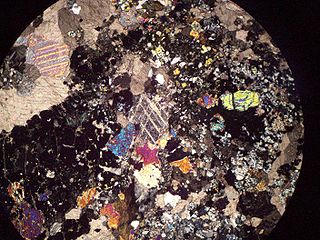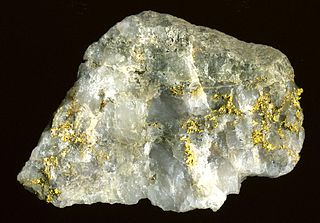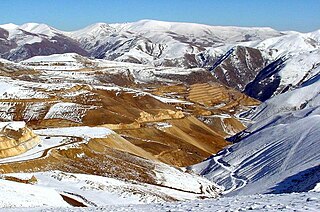
Skarns or tactites are hard, coarse-grained metamorphic rocks that form by a process called metasomatism. Skarns tend to be rich in calcium-magnesium-iron-manganese-aluminium silicate minerals, which are also referred to as calc-silicate minerals. These minerals form as a result of alteration which occurs when hydrothermal fluids interact with a protolith of either igneous or sedimentary origin. In many cases, skarns are associated with the intrusion of a granitic pluton found in and around faults or shear zones that commonly intrude into a carbonate layer composed of either dolomite or limestone. Skarns can form by regional, or contact metamorphism and therefore form in relatively high temperature environments. The hydrothermal fluids associated with the metasomatic processes can originate from a variety of sources; magmatic, metamorphic, meteoric, marine, or even a mix of these. The resulting skarn may consist of a variety of different minerals which are highly dependent on both the original composition of the hydrothermal fluid and the original composition of the protolith.

Various theories of ore genesis explain how the various types of mineral deposits form within Earth's crust. Ore-genesis theories vary depending on the mineral or commodity examined.

The Sungun copper mine is located in Varzaqan county, East Azarbaijan, Iran, 75 km north west of the provincial town of Ahar. It is the most important geologic and industrial feature in the area and is the largest open-cast copper mine in Iran and is in the primary stages of extraction.
The Baie Verte Peninsula is a large peninsula on the north central coast of the island of Newfoundland in the Canadian province of Newfoundland and Labrador.

Carlin–type gold deposits are sediment-hosted disseminated gold deposits. These deposits are characterized by invisible gold in arsenic rich pyrite and arsenopyrite. This dissolved kind of gold is called "Invisible Gold", as it can only be found through chemical analysis. The deposit is named after the Carlin mine, the first large deposit of this type discovered in the Carlin Trend, Nevada.

Goldstrike is a gold mine in Eureka County in north-eastern Nevada. It is located on the Carlin Trend, a prolific gold mining district. It is owned and operated by Barrick Gold. Since Barrick acquired Goldstrike in 1986, until 2018 it produced 44.4 million ounces of gold.

Goldmanite is a green or greenish-brown silicate mineral of the garnet group with a chemical formula of Ca3(V3+,Al,Fe3+)2(SiO4)3.
Elements: An International Magazine of Mineralogy, Geochemistry, and Petrology is a bimonthly peer-reviewed scientific journal published by 18 scientific societies: Mineralogical Society of America, Mineralogical Society of Great Britain and Ireland, Mineralogical Association of Canada, Clay Minerals Society, Geochemical Society, European Association of Geochemistry, International Association of GeoChemistry, Société Française de Minéralogie et de Cristallographie, Association of Applied Geochemists, Deutsche Mineralogische Gesellschaft, Società Italiana di Mineralogia e Petrologia, International Association of Geoanalysts, Polskie Towarzystwo Mineralogiczne, Sociedad Española de Mineralogía, Swiss Society of Mineralogy and Petrology, Meteoritical Society, Japan Association of Mineralogical Sciences and the International Association on the Genesis of Ore Deposits. It was established in January 2005.
Carl Michael Lesher is an American geologist. He is an authority on the geology and origin of nickel-copper-platinum group element deposits, especially those associated with komatiites, their physical volcanology and localization, the geochemistry and petrology of associated rocks, and controls on their composition.
Rampura Agucha is a zinc and lead mine located on a massive sulfide deposit in the Bhilwara district of Rajasthan, India. Rampura Agucha is located 220 km (140 mi) from Jaipur. It is north of Bhilwara, and northwest of Shahpura. Rampura Agucha is 10 km (6.2 mi) southeast of Gulabpura on NH 79. The mine is owned by Hindustan Zinc Limited (HZL), and has the world's largest deposits of zinc and lead.
Blackbird mine was a large cobalt mine in Lemhi County, Idaho, United States.
The Çöpler mine is one of the largest gold mines in Turkey and in the world, operated by the American Alacer Gold Corporation. The mine is located in Erzincan Province. The mine has estimated reserves of 6 million oz of gold.

El Laco is a volcanic complex in the Antofagasta Region of Chile. It is directly south of the Cordón de Puntas Negras volcanic chain. Part of the Central Volcanic Zone of the Andes, it is a group of seven stratovolcanoes and a caldera. It is about two million years old. The main summit of the volcano is a lava dome called Pico Laco, which is variously reported to be 5,325 metres (17,470 ft) or 5,472 metres (17,953 ft) high. The edifice has been affected by glaciation, and some reports indicate that it is still fumarolically active.
Farallon Negro is a volcano in the Catamarca province of Argentina. Active between about 9-8 million years ago, it was formerly a stratovolcano or a multi vent volcano. Eventually, erosion removed most of the volcano and exposed the underlying structure including subvolcanic intrusions.
The geology of Ecuador includes ancient Precambrian basement rock and a complex tectonic assembly of new sections of crust from formerly separate landmasses, often uplifted as the Andes or transformed into basins.

Bitinckë is a village in the Korçë County, Albania. At the 2015 local government reform it became part of the municipality Devoll. The village is at 700–1000 metres elevation above sea level.
Michel Jébrak is a Franco-Canadian geologist, academic and a researcher. He is an emeritus professor at University of Quebec’s Department of Earth and Atmospheric Sciences. He is a former Vice-Rector for Research and Creation at UQAM and holder of the UQAT-UQAM Mining Entrepreneurship Chair.
An orogenic gold deposit is a type of hydrothermal mineral deposit. More than 75% of the gold recovered by humans through history belongs to the class of orogenic gold deposits. Rock structure is the primary control of orogenic gold mineralization at all scales, as it controls both the transport and deposition processes of the mineralized fluids, creating structural pathways of high permeability and focusing deposition to structurally controlled locations.
La Liga Formation is a geologic formation Late Jurassic and Early Cretaceous age cropping out in Coquimbo Region, Chile. Rocks of the formation are andesites. Locally the rocks of the formation present epidote alteration. The iron ores of El Romeral mine are emplaced on La Liga Formation.








